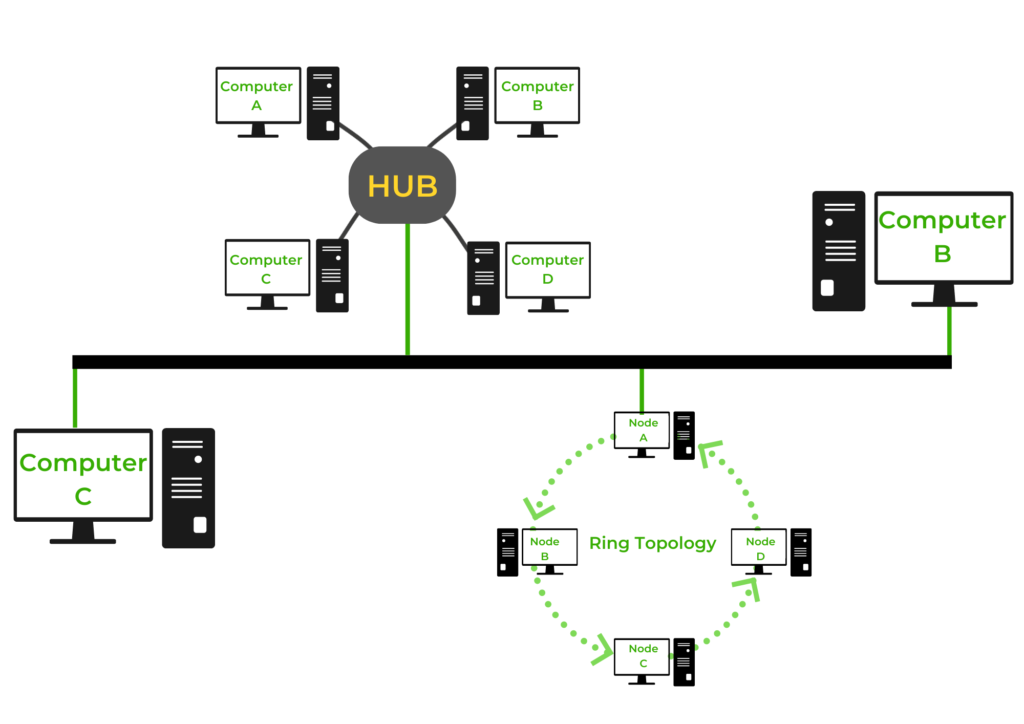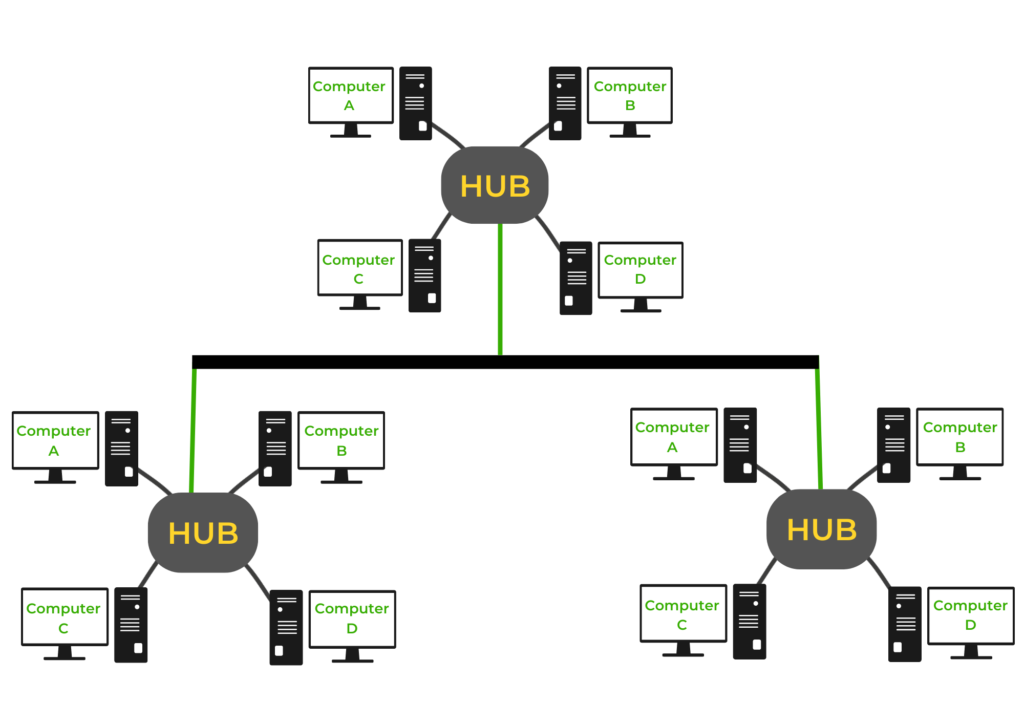In this post, you will learn about network topology and its types in a detailed explanation and example.
So let’s start learning from the very basics.
What is Network topology?
the physical or logical arrangement of the computer systems, which are connected to each other via communication medium is called network topology.
Types of Network topology
there are six types of network topologies and they are as follows:
- Bus topology
- Ring topology
- Star topology
- Mesh topology
- Hybrid topology
- tree topology

Bus topology
In a Bus topology, one long cable acts as a single communication channel, and all the nodes or computers are connected to this cable.
The cable that uses in bus topology is RJ-45 cable or coaxial cable.

Advantages of Bus topology
- Easy to add or remove computer systems in a network.
- Required only cable to form the whole network.
- It is less expensive.
- It broadcast the message to all the devices that are connected through the Cable.
- It is easy to maintain.
- In case of any computer failure, there will be no effect on any other nodes.
Disadvantages of Bus topology
- The entire network will be failed in case of cable failure.
- We can’t send private messages in bus topology.
- It takes more time to pass messages from one node to another node.
- The length of the cable is limited
- data transmission is done in only one direction.
Ring topology
It is called Ring topology because it forms a ring, and in a ring topology each node is strongly connected with its adjacent node.

Advantages of Ring topology
- It forms a strong network.
- Each and every node can share data with other nodes connected through a ring topology
- Transmission rate of data is very high.
- The data sent through this topology will be broadcast.
Disadvantages of Ring topology
- It is a very difficult task to add new nodes.
- If we want to send data from a source to a destination machine then data will be unnecessarily passed to all the nodes.
- A single point of failure, that means if a single node goes down then the entire network goes down.
- It is very difficult to recover this topology if any particular machine is not working properly.
- We can’t send private messages.
Star topology
In Star topology all the computer systems are connected with a central device called HUB and the sharing of data is only possible through HUB.

Advantages of Star topology
- It broadcast the messages.
- It is less expensive due to less cable.
- easy to connect a new computer system without affecting the rest of the network.
- If one system is failed, then it would not be a failure of the entire network.
Disadvantages of Star topology
- In Star topology, we must require a network device like HUB, Switch, etc.
- If two systems want to share the data, then sharing is only possible through HUB.
- We should not send private messages (HUB will broadcast the message).
- If HUB is failed then the entire network will be failed.
Mesh Topology
In this topology every node is directly connected with each other, so we can directly send the data to the destination machine without going to the intermediate machine.

Advantages of Mesh topology
- mesh topology is a very good topology to send private messages.
- All nodes are directly associated with another node. So, it provides point to point connection.
- Unlike ring topology, if a particular machine is failed then the entire network will not fail.
- multiple devices can send or receive data simultaneously.
Disadvantages of Mesh topology
- It is very difficult to add some new nodes because each and every computer is directly connected to another.
- If a particular machine not working then we can’t send or receive data from the failed machine.
Hybrid topology
A combination of various different topologies such as Bus, Star, Ring, etc is called Hybrid topology.

Advantages of Hybrid topology
- It is very flexible.
- We can easily add or remove new nodes without affecting the rest of the network.
- Hybrid topology is used to create large networks.
- We can modify it as per requirement.
Disadvantages of Hybrid topology
- It is very expensive.
- Design of a Hybrid topology is very complex.
- Installation process is very difficult.
Tree topology
In this topology, all the nodes are connected like branches of a tree. the combination of Bus and Star topology is called Tree topology.

Advantages of Tree topology
- We can easily add or remove new nodes without affecting the rest of the network.
- Tree topology is used to create large networks.
- It is easy to maintain.
- We can easily identify faults in tree topology.
- It is a combination of Bus and Star topology.
Disadvantages of Tree topology
- Design of a Tree topology is very complex as compared to any other topology.
- If the first level of a node is not working properly then the next level of nodes also faces the same problem.
- It is very expensive as compared to any other topology.



